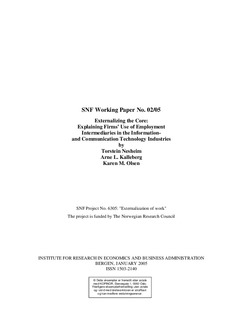| dc.contributor.author | Nesheim, Torstein | |
| dc.contributor.author | Kalleberg, Arne L. | |
| dc.contributor.author | Olsen, Karen Modesta | |
| dc.date.accessioned | 2006-06-21T07:03:00Z | |
| dc.date.available | 2006-06-21T07:03:00Z | |
| dc.date.issued | 2005-01 | |
| dc.identifier.issn | 1503-2140 | |
| dc.identifier.uri | http://hdl.handle.net/11250/165440 | |
| dc.description.abstract | Recent research on non-standard employment relations indicates that these
arrangements may be a source of innovation and competitive advantage for the firm. In this
paper, we analyze firms’ motives for using two types of employment intermediaries
(consultancy firms and temporary help agencies) in their core activities. We hypothesize that
consultancy firms are used mainly by firms that pursue an innovation strategy or demand
special competence, while temporary help agencies are used by firms that compete on low cost
or require numerical flexibility. We find empirical support for these hypotheses in a sample of
501 firms in six information and communication industries in Norway. Our results suggest that
consultancy firms, rather than temporary help agencies, are the main providers of knowledge
and innovation capability from outside organizations’ boundaries. | en |
| dc.format.extent | 87168 bytes | |
| dc.format.mimetype | application/pdf | |
| dc.language.iso | eng | en |
| dc.publisher | SNF | en |
| dc.relation.ispartofseries | Working paper | en |
| dc.relation.ispartofseries | 2005:2 | en |
| dc.title | Externalizing the Core : explaining firms’ use of employment intermediaries in the information- and communication technology industries | en |
| dc.type | Working paper | en |
